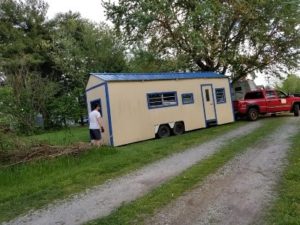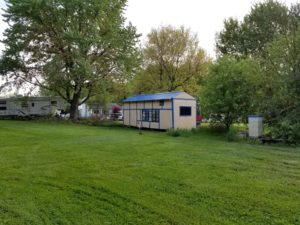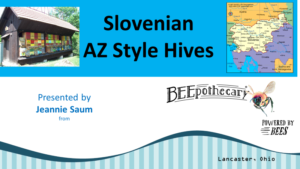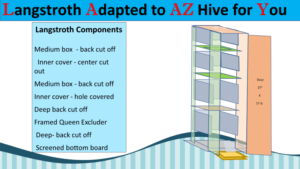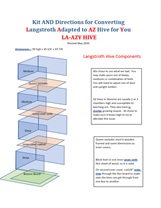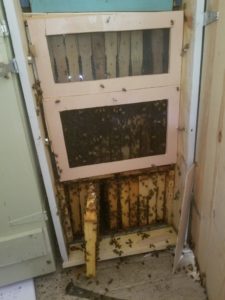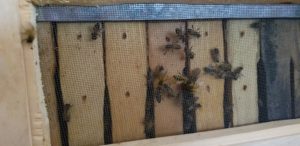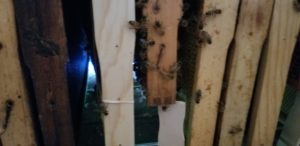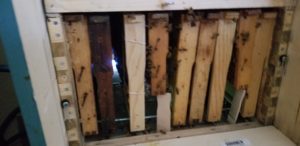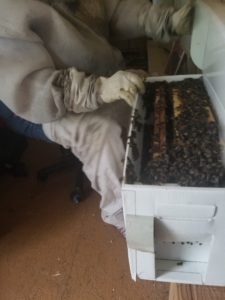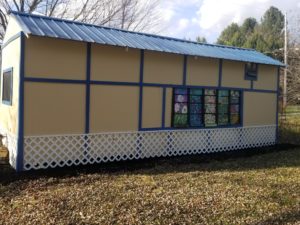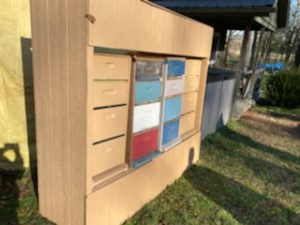Final report for FNC18-1142
Project Information
We are two families of beekeepers with eight years experience keeping bees on our one and two acre country lots, respectively. We have been keeping bees in traditional Langstroth hives, but aging and health issues have made sustaining our practice increasingly difficult due to the physicality of beekeeping. Working in the heat, as well as the standing, bending and lifting have become difficult for some of us. After learning about the way beekeeping is done in Slovenia, with AZ hives mounted in a building so beekeepers can work the hives sitting on a stool, and with much better survival rates, we wanted to try this method of beekeeping. However, changing to AZ style hives would be quite costly, at $450 each. We designed a way to use our existing Langstroth hive components and about $90 of hardware and lumber to make AZ style hives that would be compatible with frames and wax found in the US.
We will positively impact the quality of life and livelihood of beekeepers with physical limitations due to health or aging, by modifying Langstroth hives into AZ-style hives, for under $90. These hives make beekeeping tasks easier to perform and less weather dependent, allowing persons with physical limitations to continue beekeeping. Our modification will positively impact the economics of beekeeping by providing a way for beekeepers to use equipment they already have to transition to AZ-style hives instead of purchasing new AZ style hives at $450 each. We will collect data to investigate whether the ease of use of these hives improve colony survival and increases honey production, resulting in a positive economic impact. We will keep inspection records to see if the AZ style hives will change beekeepers’ practices into more ecologically sound management. Our theory is that the AZ-style, sheltered hives will increase the frequency of hive inspection and IPM because these tasks will be physically easier and not weather dependent. They can be done inside a cooled or heated structure, with little colony interruption, and less demanding physical labor. Increased care should result in healthier bees with better survival rates, showing a positive ecological impact.
1st year Report - March 2018 - February 2019
The purpose of this grant is to convert Langstroth-style bee hives to AZ-style hives to reduce the physicality of beekeeping for aging and/or handicapped beekeepers. Our belief is that these hives will help people sustain their beekeeping practice without costly alternative equipment and help improve: accessibility; ease of use; frequency of inspections; IPM; colony survival; and honey production. These hives will also open up the beekeeping field to those with physical limitations, as they allow for sitting while working with the bees and eliminate the need for heavy lifting.
We started working on our SARE Grant project, in March of 2018. Steve and Jeannie Saum took responsibility for procuring the needed hardware and lumber for building the first 10 LA-AZY (Langstroth Adapted to AZ style) Hives, as well as ordering the new Langstroth parts needed for the hives we would build for our handicapped new beekeeper. We began building the LA-AZY Hives in April 2018.
We had hoped to get the modified hives finished, into their shelters and the bees moved during this past spring-summer-fall bee season, but our schedule and the weather prevented us from reaching this goal. The building of the hives and the shelter took much longer than we expected. The amount of rainy days we had in late 2018 greatly impacted our work.
Also, as we filled the LA-AZY Hives with frames, we realized we had to do some modifications. The frames fit too snugly and there were places where correct bee space was lacking. We brainstormed some fixes and came up with a plan and the items we needed to modify. This involved taking them apart and adding more spacing with lath in between the boxes.
During the fall and winter, October 2018 - February 2019, when weather has permitted, and working around our business schedule, we have almost completed the Saum bee shelter. The Dotsons have decided to use an existing building on their property to house the new hives. The Kelletts will either put theirs in a hoop house on their new property or in a small roofed shelter that is yet to be built.
The extra time it has taken to build the components we needed has put us behind by a season, as we had hoped to have two seasons to conduct action research caring for the bees in these new hives by Feb. 2020. We will begin our beekeeping in these new hives this spring of 2019 and will be able to report on this one season. We will want to continue the field research into the spring-summer-fall of 2020 and amend our report after this additional research.
During the months of February - April 2020 we will move the honey extractor into the shelter, tow the trailer into place on our property, and add steps into the shelter. We will also modify the other 6 hives for the Dotsons and Kellers. The Dotson hives will be placed in a small garage for shelter this spring, with a tube entrance through the wall. The Keller's hives may be placed in a hoop house or we will build a small roof/shelter for them outside.
As soon as the weather warms up and the bees break their winter cluster, we will move the bees into the LA-AZY Hives. Our plan is to strap the Langstroth hives together after dark and using a dolly, wheel them into the shelter. We will move the frames, one at a time, into the new hives, at night. This process will be repeated at the Dotson’s apiary as well. We will get the Keller’s hives started with splits as the season continues.
Our plans for the second year of the grant are to document the care and progress of our bee colonies in these newly designed hives, host field days later in the season to share our project with other beekeepers, finalize the hive plans, and publish them in hard copy and online. We will seek places to present our project throughout the beekeeping community, and continue to share our progress on social media platforms. Next fall, at our state conference, we will have a drawing for five “kits” and plans for building these hives. We documented our progress on this project at https://www.facebook.com/LAAZYhive/?ref=bookmarks .
Year 2 Report - March 2019 -February 2020
Health issues of the two couples working on this grant prevented us from making much progress on the grant project during this past year. The handicapped beekeeper and spouse participating with us spent many months out of town due to their growing business.
We applied for and were granted an extension that will cover this year's bee season so we can keep bees in the newly designed LAAZY Hives and collect data. The present quarantine is preventing us from carrying out presentations and a Field Day to share our project. We are pursuing other ways to disseminate information including; ZOOM meetings, Face Book, Website, emails, and online newsletters.
FINAL REPORT SUMMARY
1)The problem that our project set out to address is the physicality required in traditional beekeeping in Langstroth hives and the difficulty it poses for aging, physically limited beekeepers, or prospective beekeepers. We learned about the Slovenian AZ- style hives and thought they might be the answer to this issue. The design of the AZ hives takes away the physical demands of beekeeping- standing, lifting, bending, carrying heavy boxes, and suffering in high heat and humidity. However, replacing one’s existing hive equipment with AZ- style hives is cost prohibitive. We set out to find an economical way to modify Langstroth hive components that beekeepers already have, into Slovenian AZ-style beehives with the use of common hand power tools that most people have. We wanted this to be doable by the average person with only basic wood working skills.
2) We educated ourselves on the features and design of the AZ-style hives and how beekeeping is done in them. We visited a beekeeper who has several different Slovenian and American- made AZ hives, mounted in a shelter. We examined AZ hives made in the US (costing over $450 each) and considered what features were required and which ones could be modified or eliminated. We created a design that would allow beekeeping in the Slovenian way - sitting in a cool shelter, opening hives from the back, one box at a time. Beekeeping in this type of hive does have differences that we had not thought of, so we have learned by doing and by consulting with more experienced AZ-hivers, how to adjust our beekeeping practice. We had to make several revisions to our design as we started using them, to solve various issues such as bees escaping, lack of adequate bee space, and different hive spacers needed.
Other lessons learned:
- Inspections are not as easy to do as we thought.
- The need for different tools.
- The bees put beeswax and propolis everywhere - not always on the frames!
- Beeswax built on top of frames was a problem, not propolis on the bottom of the frames as we had been told.
- We learned it is better to build and test one prototype and revise, revise, revise, before building many!
- Life problems get in the way of plans!
3) We designed, built, revised, and used AZ style hives from Langstroth hive components that most beekeepers already have, for less than $80 in lumber and hardware (which was less than our $90 budget projection) and using common hand power tools most people have. We demonstrated that beekeeping is possible using the AZ style hives, for people with limited mobility, health issues, or physical handicaps.
4) Our own unexpected health issues, affecting three of the four grant participants (additional back treatments; broken ankle requiring surgery and no weight bearing for 3 months; 4 eye surgeries; and a terrible case of shingles delayed our project and brought us right up to the Pandemic. The Coronoavirus quarantine and restrictions have impacted our ability to work with others directly on trying this new way of beekeeping.
Beekeeping is hard to learn virtually. We have used social media, YouTube, and Zoom to share with others, but once we can resume face to face contact, we will be more successful in sharing this way of beekeeping with others. We have given out 20 hive building kits and building instructions to beekeepers with physical limitations, interested in building and trying these hives. Additionally, we have published our plans online and advertised on several social media sites. In addition, we will present a PowerPoint of our project as part of Ohio State Beekeepers Association's 2021 Live Webinar Training Series, offered via ZOOM on the second and fourth Sunday evenings at 7:00 pm. (Date TBA at ohiostatebeekeepers.org)
This project has allowed participant and grant manger, Jeannie Saum, to participate in beekeeping again, after not being able to for 3 years. Failed back surgeries, chronic pain and limited ability to stand and walk, had prevented her from performing most beekeeping tasks. All she could do was sit in a lawn chair and take notes of the inspections her husband, Steve, was doing. With our new hive design (and an old golf cart to get out to the hive shelter), she can now go out and inspect and care for the bees, herself.
We have met our goals with some modifications due to the quarantine restrictions. We will continue to collect data of hive inspections and work with interested beekeepers, even after the grant program is concluded.
- Finalize design of hive modification.
- Modify hives into AZ-style hives, place in shelters.
- Enlist two handicapped or older beekeepers to test use of modified hives. Participants will collect data on: ease of use, accessibility, frequency of inspections, pest checks, pest infestation, treatments, time spent on hive care, IPM, feeding, colony survival, swarm and absconding rates, honey production.
- Host Field Day to demonstrate AZ-style hive design and project.
- Present design and results at beekeeping meetings/conferences, publish online.
- Raffle off 5 modification kits to beekeepers with physical limitations.
- Publish plans for modification, present project findings.
1st year Project Report - March 2018-February 2019
During the months of April and May, once the weather warmed up enough for outside work, we held several ork days to build the LA-AZY Hives. Present were Steve and Jeannie Saum, Beekeepers; Peter and Laurie Dotson, beekeepers and partners in the project; and Brian and Emily Kellett, new beekeepers (Brian is wheelchair bound). We set up an assembly line system,with each of us doing a part of the build process. We also had help from some friends and family members over the course of the building process
Covering objectives 1 and 2 from above we started with building the hive components:
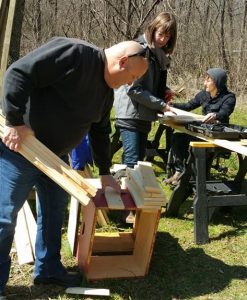
- cutting the ends off hive boxes to be the doors,
- cutting a “window”hole in each door,
- Stapling screen over the opening,
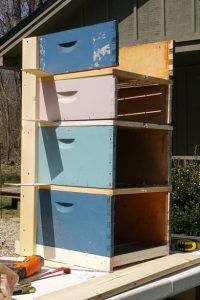
- drilling hole for and placing steel rods across the bottom of the boxes to support the frames,
- cutting slots in inner covers,
- cutting the 1 x 4 support lumber that would hold the boxes together,
- assembling the stacks of 4 boxes and spacers, securing them with the 1 x 4 uprights,
- building a large “back door” that covers the stack of boxes on the back,
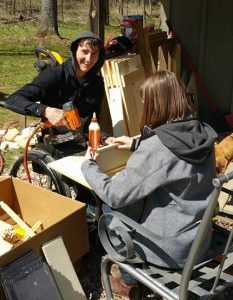
- adding a lid and hardware closures.
- Putting together frames for our new beekeepers and adding them to their boxes.
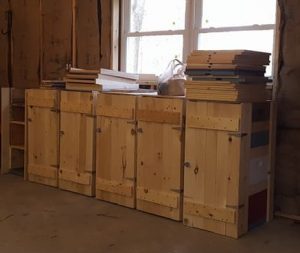
After the hive building process was finished, we met for some painting days. We painted the outside of the hives and door, to seal the wood, using “Oops Paint” (mis-tints).
In May, we found an old trailer to use for the Saum’s beehive shelter. Steve Saum started working on gutting the interior of the trailer to prepare it for use as the bee shelter. Jeannie Saum painted scenes on their hive fronts to mirror the painting of folk art on the AZ hives in Slovenia.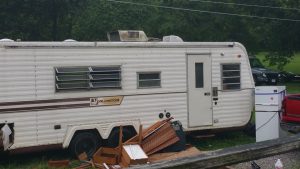
From June to September, Steve Saum worked mostly independently on re-purposing the trailer, since Jeannie Saum’s multiple back surgeries have left her limited in what she can do (one reason for this project). He did enlist son, Nathan to help on occasion. He carried out the following tasks:
- gutting the interior of the trailer
- Replacing the floor
- framing the exterior
- Adding T-111 wood to the exterior and trim to give it “curb appeal” for the neighbors’ sake
- Added a metal roof with overhang that protects the front of the hives mounted in the wall.
- Jeannie Saum cut and painted the trim for the exterior, since she could do these tasks sitting down!
- Before the weather turned too cold to work outside, we were able to get the exterior and interior painted and the header beam for the cut-out wall up.
We had hoped to get the modified hives finished, into their shelters and the bees moved over during this past spring-summer-fall bee season, but our schedule and the weather prevented us from reaching this goal. The building of the hives and the shelter took much longer than we expected. The amount of rainy days we had in late 2018 greatly impacted our work. This had put us behind by a season, as we had hoped to have 2 seasons to conduct action research caring for the bees in these new hives by Feb. 2020.
Also, as we filled the LA-AZY Hives with frames, we realized we had to do some modifications. The frames fit too snugly and there were places where correct bee space was lacking. We brainstormed some fixes and came up with a plan and the items we needed to modify. This involved taking them apart and adding more spacing in between the boxes.
During the fall and winter, October - February, when weather has permitted, and working around our business schedule, we have almost completed the Saum bee shelter. The Dotsons have decide to use an existing building on their property to house the new hives. The Kelletts will put theirs in a hoop house on their new property or in a small roofed shelter that is yet to be built.
The extra time it has taken to build the components we need has put us behind by a season, as we had hoped to have 2 seasons to conduct action research caring for the bees in these new hives by Feb. 2020. We will begin our beekeeping in these new hives this spring of 2019 and will be able to report on this one season. We will want to continue the field research into the spring-summer-fall of 2020 and amend our report after this additional research.
We have done the following to prepare the bee shelter to house our bees this spring:
The hives sit on a shelf. Underneath is storage where we have plastic tubs to hold extra frames with wax, so wax moths won't get into them. All equipment is in the Bee Shelter - tools, jackets, Honey extractor, work tables, stools, sink and AC.
During the first week of May 2019, we moved the Bee Shelter into its place on our property.
Later that week, we installed a swarm that Steve Saum and Laurie Dotson caught at the local golf course. This ended up being more than we bargained for and different than installing a swarm in a Langstroth hive. A weather front was moving in, it was late in the day and the bees were agitated. I ended up with about 10 stings - due to my back pain and movement issues plus being in a closed shelter, I couldn’t get away! We wish we had watched the You Tube video we found, later - before we attempted this install! There WAS an easier way!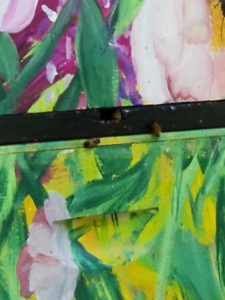
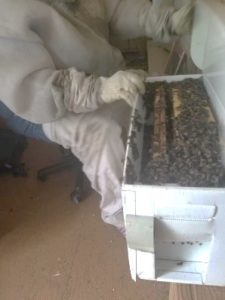
In May and June, we added a nuc we were given by a friend into a LAAZY Hive. We made a split of the 8 -frame hive in the apiary. We had wanted to move the entire hive into a LAAZY hive but realized that the 8-frame hive had medium boxes and frames on it. We needed deep frames for the bottom two boxes of the LAAZY HIVES. We moved over a split, using the deep frames in the 8-frame hive and a swarm cell from the nuc we were given. We had to leave the 8 - frame hive in the apiary, until the brood hatches in the 8 - frame boxes.
Jeannie was excited to be able to go out and feed the bees by herself. She could ride her golf cart out to the Bee Shelter, climb in, sit on a rolling chair and open the hives to feed. This was the first time she was able to do beekeeping tasks since her second back surgery three years earlier!
We were all ready to spend the summer tending to our bees and getting the Dotson’s shelter built and LAAZY 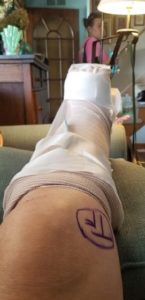 Hives installed, when Jeannie fell and triple fractured her ankle, requiring surgery, two months of no weight bearing on the foot, and three subsequent months of slowly walking on it again and doing physical therapy. I the meantime, Peter Dotson came down with a terrible case of very painful Shingles that lasted two months and prevented him from being able to do anything, including sleep! These medical issues resulted in a half of our grant activities, as spouses were tied up taking care of the invalids and all the household chores and responsibilities. It was at this time that we submitted a request for an extension that would last through the bee season of 2020.
Hives installed, when Jeannie fell and triple fractured her ankle, requiring surgery, two months of no weight bearing on the foot, and three subsequent months of slowly walking on it again and doing physical therapy. I the meantime, Peter Dotson came down with a terrible case of very painful Shingles that lasted two months and prevented him from being able to do anything, including sleep! These medical issues resulted in a half of our grant activities, as spouses were tied up taking care of the invalids and all the household chores and responsibilities. It was at this time that we submitted a request for an extension that would last through the bee season of 2020.
Despite our neglect, the bees did well in their new homes. We treated for mites in the fall and fed them 2:1 syrup. They had a box of honey stores going into winter. Two strong hives and one weak one.
In September, the Saum's drove to Fremont Ohio to see the Bee shelter and AZ hives of Evelyn Lepard, an AZ hive beekeeper Jeannie had met in an online Facebook group for AZ Hivers. They spent an afternoon getting a tour of her Bee House, examining three different companies AZ style hives in her shelter and discussing beekeeping how-to's in these hives. They got some great ideas for tools to use and ways to arrange the Bee Shelter.
Two of the three hives at the Saums' made it through winter. Interestingly, Laurie Dotson took very good care of her bees in Langstroth hives. Due to the weather she unfortunately lost five out of six hives.
In January - March of 2020, we modified the six hives for the Dotsons and Kelleys, put spacers in to add bee space and replaced the screen doors that were letting bees out. We also built 4 swarm traps and pollen-feeder lures. In April these traps have been put out in undeveloped areas in an attempt to catch feral swarms.
A veteran beekeeper is mentoring our bee club on catching feral swarms. Here in Ohio, there have been areas found where the feral bees have naturally developed varroa mite-chewing behaviors, which is desirable, as the bees are killing mites without pesticides. We want the genetics of these bees in our apiary gene pools. We will check on these swarm traps every two weeks, and install any swarms we catch, in our LAAZY hives.
This April, 2020, we will be putting up a shelter for the Dotsons’ LAAZY Hives and installing their hives and bees. We will also install the Kellets' hive and bees in a glass greenhouse they built for their plant business (task 3).
During the summer of 2020, we will be tending our bees in the LAAZY Hive and keeping documentation. We have already found that use of a smoker is still necessary and that propolis build up is happening ABOVE the frames instead of below, requiring a longer tool to break frames free. A long-bladed machete is now our hive tool of choice.
We had planned to do a talk on these hives for a beekeeping club in June, but due to the COVID - 19 ban on gathering, we aren’t sure. We have offered to do the presentation via Zoom, as someone in the Ohio State Beekeepers Association (OSBA) has offered to host large zoom meetings on his super computer (task 5). We are waiting to hear if the club wants to do this type of meeting.
Tasks 4-6 will be carried out eventually, but with the quarantine, we don’t know when. We had planned to have a drawing for hive conversion kits at a bee conference, but there probably won’t be one in the near future. We know a few elderly beekeepers - from our local bee club and our nuc/queen provider -who might be interested in trying these hives. We could give a few kits to these gentlemen. We might advertise a distance drawing through the Ohio State Beekeepers Newsletter and disseminate the kits in this manner (Task 6).
The lack of meetings and conferences will impact our ability to share our project in person, but it appears that OSBA will be offering Zoom Conferences during this time, so that could be a way for us to share our LAAZY Hive SARE Project. We have much interest from other beekeepers in coming to a Field Day to show our LAAZY Hives.(Task 4) This will have to wait until the quarantine is lifted or be done as a virtual Field Day.
Task 7 is to publish our LAAZY Hive plans. The plans are almost ready for publishing. We just want to be able to include any beekeeping tips we might learn this season, along with the plans, measurements and how-to's. Our target date for publishing the plans is Sept. 2020. These will be disseminated through the OSBA Newsletter, our Face Book pages, emails, and at any meetings or conferences that might be eventually permitted. Update: View the published plans here.
FINAL REPORT
Project Objectives Met:
- Finalize design of hive modification. - Several modifications of design were made as they were put into use. Design plans complete and published online and advertised on social media.
- Modify hives into AZ-style hives, place in shelters. - Hives placed into two different shelter designed and bees installed. Success overwintering in these hives.
- Built and revised 10 AZ hives and Saum’s and Dotson’s have put them into use.
- Built 2 different types of shelters for the AZ style hives
3. Enlist 2 physically limited/older beekeepers to test use of modified hives. - Found two different, physically limited beekeepers to try out the LAAZY Hive, to replace those who had initially committed to working with us. (Wheelchair bound friend moved to Savannah for business; one elderly beekeeper friend passed away; another couple got out of beekeeping when the wife started having anaphylactic reactions to bee stings.) These new participants will begin using the hives next season and we will continue to report on their experience on our website, in addition to gathering data from those who were given the starter kits.
4. Participants will collect data on:
- Ease of use / accessibility - has allowed Jeannie Saum to resume beekeeping after multiple unsuccessful back surgeries that have limited her mobility. Have found that getting frames in and out is not as easy as we thought it would be. Also, changing out the dividers between boxes was difficult due to propolis deposits. We had to consult another AZ beekeeper for advice as to how to do this. Modification of changing out the frame spacers to some specifically designed for AZ hives and redesigning doors to fit differently has helped ease of use.
- Frequency of inspections / pest checks - We have just gotten electricity run to our indoor camper hive shelter, so inspections did not happen as frequently as they should have during this hot summer. Now that we can have a cooled shelter, inspections will be easier and more frequent in the future.
- Pest infestation / treatments - mite load has been controlled. We are using sumac cones in smoker. They contain formic acid. Did not find doing mite checks any more cumbersome than in a traditional hive. No problem with hive beetles since hives are off the ground. No problem with hive moths.
- Time spent on hive care – inspection, IPM, feeding - not as frequently as they should have been inspected. Will do better next season, now that we have solved some inspection issues and will have a cooled space. Discovered, recorded and solved some unexpected issues related to how hive inspections are done in these hives - different tools needed, modifications to bee suits, procedures for changing out the box dividers to give bee access to the next box as hive grows. (These notes are all found in the published hive directions.)
- Colony survival, swarm and absconding rates - In the first year of use, two of the three hives in shelter at Saum’s have thrived , one hive seems to have absconded. This hive struggled from the beginning. It started out as a nuc from a friend, but it had several medium frames that we tried to put in the deep box of the LAAZY Hive by propping them up. Bees built crazy comb and we had to tear it up to try to inspect. Hive just never thrived.
- Honey production - Harvested two supers of honey from Saum’s LAAZY Hives, with enough left for overwintering bees. Dotsons were also able to harvest a full box from each of their AZ-style hives.
5. Host Field Day to demonstrate AZ-style hives. We were unable to do this in person due to coronavirus restrictions. Project coordinator has had to work on the final tasks of this grant between further treatments for her chronic back pain. Modifying the remainder of the hives has taken much time. We ran out of warm weather to do our video tour of the hives and inspection. This will be conducted next spring and posted online. We intend to continue to share our project with others, as we know there is a need in the beekeeeping community. Our involvement with our local bee club and the state beekeeping organization gives us many opportunities to do so, even during the pandemic. We are on the speaker list for the state organization and have a presentation ready!
6. Present design and results at beekeeping meetings/conferences, publish online. -
- We have created and presented a PowerPoint Presentation on the LAAZY Hive. (presented at East Central Ohio Beekeepers Association June 18, 2020. This presentation is posted online at BEEpothecary.Wordpress.com.
- We have prepared a PowerPoint presentation that will be part of Ohio State Beekeepers Association's 2021 Live Webinar Training series. This will be published on ASBA's YouTube channel after it is presented live.
- Created a Facebook page to document our progress and run our drawing.
- Wrote and published the plans for the LAAZY Hive.
- Posted the plans online via Facebook and our website for others to access.
- If the Tri-county Beekeepers Conference in Wooster Ohio, is done in person in March 2021, we will pursue presenting our project at this venue.
7. Drawing for 5 modification kits to beekeepers with physical limitations - Compiled 20 LAAZY Hive starter kits using extra funds not needed for in- person Field Day and travel. We advertised the kits first on our LAAZY Hive Facebook page, to those who had been following us. Then we posted on other beekeeping Facebook pages, awarding the kits to beekeepers in need of an easier way to keep bees. This was done on a first come, first served basis.
Research
1st year Report - March 2018 - February 2019
Research on this project will start this spring 2019.
2nd Year Report - March 2019 - March 2020
We were unable to collect much research this past year due to health issues that limited our beekeeping. We did discover that the bees seem to be laying down propolis differently than in the Langstroth hives and that a longer tool, such as a machete, is needed to free up the frames. Winter survival rate for the LAAZY hives was 66% compared to a survival rate of 29% for the Langstroth Hive
Final Report: Our research was mostly action research in the field. Through the use of the hives during the 2020 bee season, we found several issues with our design that needed to be modified, and some issues with our equipment. Bees were making comb in unusual places and not on the frames, Bee's were escaping through tiny cracks around the doors and we were having difficulty getting frames back in and spaced correctly.
We took the beehive stacks apart to add back "bee space" (taken away when we added rods in the bottom of each box) with thin molding on the top rims of the boxes, hoping this would help with where they were putting comb. We redesigned doors and the way they are attached, fitting them over the hive box edges, rather than in between. We replaced frame spacers with some we found that were designed especially for AZ style hives.
We also consulted with a veteran AZ-hive beekeeper as to her practices with inspections and changing out the dividers. After this consultation, we added a specially designed box for holding frames, called the Hive Butler, to store frames while we inspected or moved the dividers to enlarge the hive as the colony grew.
We also discovered during the actual use of the prototype the need for an inspection tray to keep bees off ones lap, reinforced bee suit pants to make them sting-proof, and used a different style veil that wouldn't fall down over one's eyes as one bent over to peer inside the hive. These all are unanticipated yet insightful results of beekeeping from a sitting position that we discovered!
Hives being off the ground has meant less trouble from insects and 4-legged pests. Our winter losses last winter were less than we have had in our traditional apiary. We assume this is at least in part due to the protection from wind and weather the hive design and hive shelter provide. We hope this winter will result in the same. We will continue to keep track of data.
Ease of use / accessibility - has allowed Jeannie Saum to resume beekeeping after multiple unsuccessful back surgeries that have limited her mobility. This was the major goal of our project. We discovered that getting frames in and out is not as easy as anticipated. Also, changing out the dividers between boxes was difficult due to propolis deposits. We had to consult another AZ beekeeper for advice as to how to do this. We have found that different tools and procedures are needed to inspect and some modifications to bee suits are needed to address the differences of sitting down while inspecting. For many physically disabled beekeepers, beekeeping using traditional Langstroth hives is not possible, so this project has demonstrated a possible, successful alternative.
Cost - converting one's own traditional Langstroth hive parts into an AZ style hive using our plans, is 18% of the cost of purchasing an AZ style hive in the US, excluding shipping costs.
Colony survival - has been better than what we have documented in our Langstroth hive apiaries.
Yield has been at least equal to the yield we have had in our traditional apiary in past years.
Pest control has been easier and less necessary than in our traditional apiary.
Educational & Outreach Activities
Final Report Edit - Our Lazy Hive Facebook site is a PAGE, not a group and does not have the feature to post documents. So, the LAAZY Hive Facebiij site directs people to our local bee club GROUP where the documents are uploaded into the file page.
Participation Summary:
We are still in the build and preparation stage of our project, but we share our project and its objectives during any beekeeping activities we participate in. We attend many state beekeeping conferences and local beekeeping clubs to speak and vend our value-added hive products at and we always share our SARE project and progress to date. We post online to our LAAZY Hive Beehive Face Book page. We have conducted many casual tours and demonstrations of our LAAZY Hive prototypes and the hive shelter as it is being retro-fitted. We have had several requests for our plans, which will be released once we do our beekeeping research. We also have included information about our project in some of our Power Point Presentations that we do at beekeeper meetings and conferences.
In year two and likely into year 3, we will be posting our bee inspection results on our Face Book page, writing press releases, hosting Field Days to show our beekeeping set up with these hives, publishing our final plans online and in hard copy, and doing presentations at bee clubs. We will also have a drawing for 5 conversion kits to give away at our state conference in November 2019.
Year 2 - We have continued to post our progress on our LAAZY HIVE Facebook page and talk about the project and show photos at every club meeting and conference we have attended. In addition, Jeannie Saum wrote an article titled, Beekeeping for the Differently-Abled", published in Therapeutic Thymes magazine, published in the Fall 2019 edition. This article will also be submitted for publishing in the OSBA Newsletter at some point in the future. 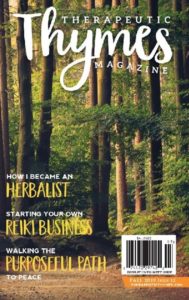
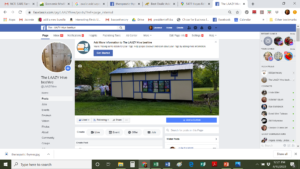
Final Report
We have used our LAAZY Hive Face Book page as well as our local bee club's Face Book page to share our progress. We also used these social media pages to carry our our Hive Kit Give-Away. We have posted progress photos on both of these sites. In addition, we have held one of two scheduled webinars telling about our project and have two published articles about it. One article entitled "Beekeeping for the Differently Abled" was published in Therapeutic Thymes Magazine - FAll 2019.Another will be published in Ohio State Beekeeper's, January 2021 Newletter, which has a circulation of over 7000.
We published LAAZY Hive plans, building sequence and accessories documents on our social media site and are attached as a product to this document. These are accessible and downloadable to the public on our social media pages.
We have held a Webinar on AZ style hives and our project for East Central Ohio Beekeepers Association for approximately 30 people and are on the schedule for Ohio State Beekeepers Association's Webinar Training Series for early 2021. This series has had between 125 - 400 people in attendance, and is open to anyone.
We have 20 interested physically limited beekeepers who will receive the hardware kits and plans, to make a LAAZY hive from their Langstroth components. We have encouraged them to keep up posted about their experiences.
Learning Outcomes
What we have learned so far this first year is that things always take longer than expected and cost more than expected.
We will have more to report after we care for our bees in the new hives in year 2.
Year 2 - March 2010 - February 2020
We have learned that a handicapped person CAN keep bees in the LAAZY Hive with the modifications we have made. We also saw that the LAAZY hives in the Bee Shelter had a better survival rate compared with hives left out in the weather (though the sample was small). Due to health issues, we were not able to complete much hive care last season. We will be doing much more this bee season and have more data to report.
During the limits of the quarantine we are all now experiencing, we are having to learn how to get things accomplished differently and will be learning new ways to communicate and share information in the coming months.
Final
- Life problems get in the way of plans! Nothing seemed to go as we planned this project due to sugeries broken bones, illness and then the coronavirus pandemic.
- We learned it is better to build and test one prototype and revise, revise, revise, before building many! We were anxious to get several built and get bee in them. It would have been better to build one, put bees in it and test and revise, before building others. As a result, we hade to disassemble allt he ones we had built and modify them.
- Inspections are not as easy to do as we thought and require some procedures and equipment. We needed aplace to put framesof bee while we inspected, or when we were trying to swap out the dividers os hives could grow. (Due to the sticky propolis the bees glue everything together with, this changing of dividers required the use of a hammer! And the bees don't like the hammer! After consulting with our experienced AZ hive used, we found that taking out a whole box of bee frames and putting them in a Hive Butler box, was much better for the bee and the keeper- preventing angry bees and stings.
- Need different tools and bee suit parts. We foudn that a regular hive tool was not long enough to loosen frames and that bee stings on top of the knees was a problem when sitting to inspect. A machete, an inspection tray to catch bees and modifications to our bee suit pants were necessary!
- The bees put beeswax and propolis everywhere - not always on the frames! We suspect this was an issue because we didnt' have a lot of drawn comb and put in plastic foundation. Next time we will coat the new foundation with wax.
- Beeswax built on top of frames was a problem, not propolis on the bottom of the frames as we had been told. We suspect this was due to too mcuh bee space and could be rectified by turning the dividers over to provide a shallower space above the frames.
- This project DID provide a way for physically limited peopole - in particular, the grant leader - a way to do beekeeping. This was not possible before. Being able to sit and not have to lift heavy boxes, iare the key design fetaures that make this possible.
- It is possible for someone with just average woodworking skills and hand-held power tools, to make an AZ style hive from Langstroth components. This can be done for less than 1/5th of the cost of buying US made AZ style hives.
- We would recommend to anyone who finds that the physical demands of beekeeping are becoming an obstacle, or to anyone who is physically handicapped but interested in beekeeping, to consider this type of hive. Converting Langstroth components to this style hive does take work, but if the motivation to continue (or stat) beekeeping is there, it is definitley do-able. The only thing we would not necessarily recommend is using an old camper as the bee shelter. Though it was cheaper than actually building a structure of the same size, the work involved was greater due to the demolition and cleanup that has to be done. A yard shed, a garage, or specially built building is probably the recommeded way to go. The outdoor simple shelter is easy and les expensive to do, but does not provide a comfortable enviroment for the beekeeper, if heat and weather are an issue.
Project Outcomes
Will have a report on this aspect after year 2.
Jeannie Saum, Grant coordinator, has been able to go out to the Bee Shelter and work with the bees in the LAAZY hives, despite her limited mobility and back pain. Being able to sit down to do beekeeping and not have to lift things makes this possible.
Final
We have 22 beekeepers interested in building and using these hives for the next bee season. Two of them have received the hive kits and plans. These recipients are from around Ohio and one from Kansas. Two more will receive and use the hives we built and then modified, to replace the original participants we lost due to relocation and bee allergy. The grant leader has been able to do beekeeping during the 2020 bee season, while sitting in her beehive shelter.
Depending on what the project is or what crops or animals one is working with it might help if the timeline for starting and ending the project or reports is determined by the project. For instance, in order or us to get in a full bee season of data (April to November) we had to ask for a longer extension.
Final Report
We have appreciated the granted extension to this project (due to broken bones, surgeries and illness) and the modifications that were allowed due to the coronaovirus pandemic and other life circumstances. We intend to continue to document the use of these hives and share information with others. The grant leader, Jeannie Saum, is president of their local bee club and is the incoming Secretary for Ohio State Beekeepers Association, giving us many connections for sharing the project beyond the grant period. Recently we have seen that people in the beekeeping community (which has historically been very resistant to change), are starting to talk about the AZ style hives for the physically disabled. In the future, we would like to find some connections for sharing this project with organizations serving the handicapped and wounded veterans.
We included an excel spreadsheet that lists the participants who are all recipients of the Hive Kits and plans, mailed out the first week of December. We had to wait on back-ordered frame-spacers to come in, so mailing was delayed. We would suggest waiting until February or even May to contact the people listed, to give them time to at least get their hives built (February ideal in Ohio), or bees into the hives (May).
Information Products
- LAAZY Hive Kit Winners (Bulletin)
- A-Z Style Hives From Langstroth Components (Conference/Presentation Material)
- The LAAZY Hive Plans: Directions for converting your Langstroth components into an AZ-style hive (Manual/Guide)
